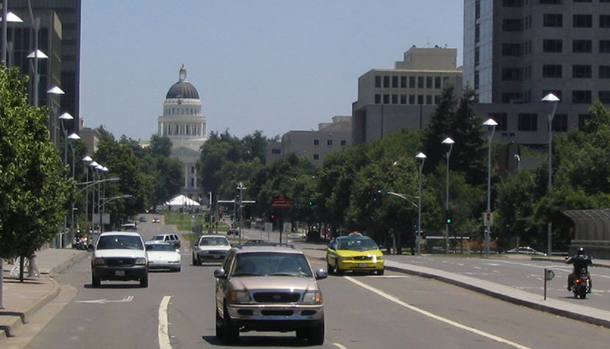
(Photo Credit: Ken Lund/Flickr)
UPDATE April 7: The Legislature passed the SB 1 transportation funding bill on Thursday night, complying with California's new voter-approved transparency rule contained in Proposition 54 requiring bills be published online for 72 hours before a final vote. Read more in our latest story: Something very important happened in Sacramento this week in full view of public
——————–
With a vote looming this week on a $5.2 billion per year proposal for road maintenance and transit operations, the Legislature could be poised to score a win for performance, accountability and transparency.
After two years of discussion, the Governor has asked lawmakers for final action by Thursday, April 6. The proposal has had to evolve in response to public and lawmaker concerns that the money might get diverted to some other priority, or it would not fix enough potholes and bridges. And as it makes its way through the Legislature, the measure must comply with the new voter-imposed requirement that the public and lawmakers have at least 72 hours to review the bill before the vote.
In abiding by last year’s Proposition 54, the Legislature is meeting a new minimum transparency standard on one of the hardest decisions that any lawmaker is asked to make – in this case raising gas taxes, diesel sales taxes and new vehicle fees.
The measure was amended and approved by the Senate Appropriations Committee and “read” on the Senate floor on Monday afternoon. The measure has been marked by the parliamentarian that it cannot be approved by the Senate until Thursday afternoon – and to meet the Governor’s deadline and satisfy the law, the Assembly will need to vote on the measure on Thursday without amending the bill.
If two-thirds of the Legislature approves the tax hikes, an estimated $5.2 billion a year would amount to a vital and long-overdue commitment toward meeting an almost $300-billion gap in funding for transportation infrastructure and transit operations.
Tax politics are always hazardous in California, and even with supermajority control by the Democrats, mustering the two-thirds votes in the Legislature is a major challenge. But the administration and its allies have meaningfully addressed the major criticisms of previous tax measures.
The final bill satisfies all of the criteria for sustainable tax policy identified in CA Fwd’s 2015 Financing the Future series. Recognizing the enormous investments that will be required for California to grow in equitable and sustainable ways, CA Fwd engaged allies to produce a series of guides intended to inform tax-related discussions and proposals.
SB 1 would balance equity concerns (by pairing regressive gas tax hikes with more progressive new vehicle value fees). It would produce significant revenue that would be fairly stable. And it would fund activity that encourages economic growth and efficiency—all in the service of meeting a clearly defined state priority: maintaining California’s road and transit systems.
When it comes to accountability, the bill includes four reforms with significant potential to improve performance over time and restore confidence that tax dollars are well spent.
First, a companion measure, Senate Constitutional Amendment 2, requires that all of the revenue from the gas taxes and vehicle fees must be spent on transportation. Voters have long complained that these taxes are sometimes used for purposes other than improving roads. SCA 2 would amend the constitution to prevent future governors and legislators from taking money for potholes and using it to fill some other hole in the budget.
Second, the legislation increases the California Transportation Commission’s ability to provide oversight of transportation funding.
Third, the measure establishes clear performance metrics and goals. By 2027, the Department of Transportation is expected to achieve the following:
- Not less than 98 percent of pavement on the state highway system in good or fair condition.
- Not less than 90 percent level of service achieved for maintenance of potholes, spalls, and cracks.
- Not less than 90 percent of culverts in good or fair condition.
- Not less than 90 percent of the transportation management system units in good condition.
- Fix not less than an additional 500 bridges.
While these are extremely high targets, they set expectations for steady management improvements over the next decade.
And four, the bill would create a new Independent Office of Audits and Investigations. The office will be directed by an Inspector General who is appointed by the governor and confirmed by the Senate to a six-year term. The office will monitor Caltrans, local agencies, and nonprofit organizations that receive funding to make sure the money is spent “efficiently, effectively, economically, and in compliance with applicable state and federal requirements.”
Caltrans leadership has been working to modernize the agency for years—and these new provisions if implemented well would build on reforms already adopted by the Legislature and the department to address concerns of bloated bureaucracy and poor project management.
As always, passing a large tax bill will be a high political hurdle. Effective implementation will pose its own challenges, and effective oversight will be a critical navigational tool to getting where we need to be.
But in a time national political leaders are gridlocked by mutually exclusive visions for where the nation should head, we should acknowledge the earnest efforts being made in California to listen to the public, seek compromise and do the best we can — with a little more sunshine and accountability.

